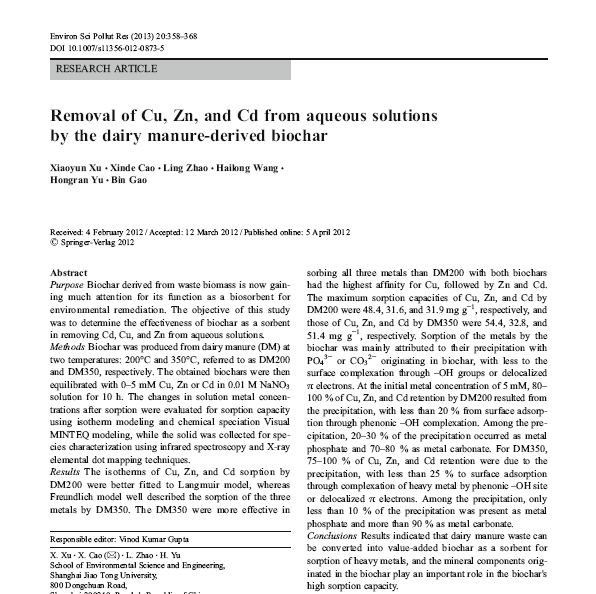Removal of Cu, Zn, and Cd from aqueous solutions by the dairy manure-derived biochar
2017-11-27
Xiaoyun Xu & Xinde Cao & Ling Zhao & Hailong Wang & Hongran Yu & Bin Gao
Abstract
Purpose Biochar derived from waste biomass is now gaining much attention for its function as a biosorbent for environmental remediation. The objective of this study was to determine the effectiveness of biochar as a sorbent in removing Cd, Cu, and Zn from aqueous solutions. Methods Biochar was produced from dairy manure (DM) at two temperatures: 200°C and 350°C, referred to as DM200 and DM350, respectively. The obtained biochars were then equilibrated with 0–5 mM Cu, Zn or Cd in 0.01 M NaNO3 solution for 10 h. The changes in solution metal concentrations after sorption were evaluated for sorption capacity using isotherm modeling and chemical speciation Visual MINTEQ modeling, while the solid was collected for species characterization using infrared spectroscopy and X-ray elemental dot mapping techniques. Results The isotherms of Cu, Zn, and Cd sorption by DM200 were better fitted to Langmuir model, whereas Freundlich model well described the sorption of the three metals by DM350. The DM350 were more effective in sorbing all three metals than DM200 with both biochars had the highest affinity for Cu, followed by Zn and Cd. The maximum sorption capacities of Cu, Zn, and Cd by DM200 were 48.4, 31.6, and 31.9 mg g−1, respectively, and those of Cu, Zn, and Cd by DM350 were 54.4, 32.8, and 51.4 mg g−1, respectively. Sorption of the metals by the biochar was mainly attributed to their precipitation with PO43− or CO32− originating in biochar, with less to the surface complexation through –OH groups or delocalized π electrons. At the initial metal concentration of 5 mM, 80– 100 % of Cu, Zn, and Cd retention by DM200 resulted from the precipitation, with less than 20 % from surface adsorption through phenonic –OH complexation. Among the precipitation, 20–30 % of the precipitation occurred as metal phosphate and 70–80 % as metal carbonate. For DM350, 75–100 % of Cu, Zn, and Cd retention were due to the precipitation, with less than 25 % to surface adsorption through complexation of heavy metal by phenonic –OH site or delocalized π electrons. Among the precipitation, only less than 10 % of the precipitation was present as metal phosphate and more than 90 % as metal carbonate. Conclusions Results indicated that dairy manure waste can be converted into value-added biochar as a sorbent for sorption of heavy metals, and the mineral components originated in the biochar play an important role in the biochar's high sorption capacity.
